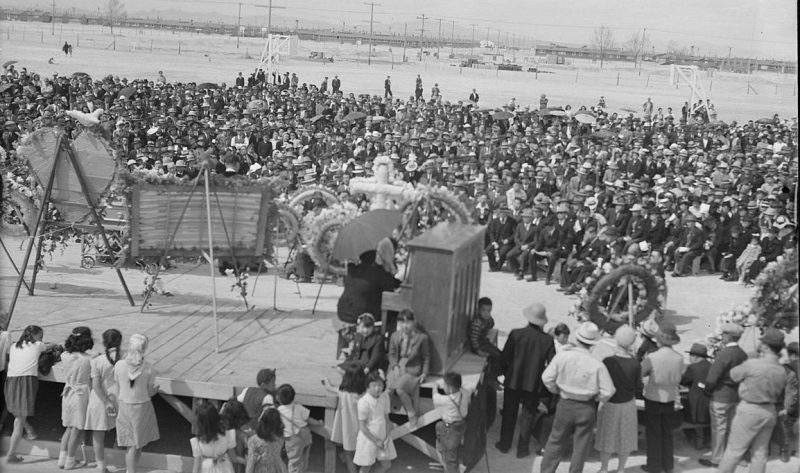“It makes no difference if he is an American citizen or not. He’s still Japanese … I don’t want any of them here. They are a dangerous element. There is no way to determine their loyalty.”
These words, from the mouth of Gen. John DeWitt, commander of the Western Defence Command for the U.S. Army at the time of the Pearl Harbour attack during WWII, were instrumental in persuading the government that the Japanese immigrants living in California, Oregon, and Washington, be removed from their homes, and interred as a matter of national security.
It was not until 1983 when the Commission on Wartime Relocation concluded two years of hearings that a formal statement on the grave injustice handed out to Japanese immigrants during WWII was made public. “Interned Japanese-Americans suffered a grave injustice, conceived in haste and executed in an atmosphere of fear and anger at Japan. Their imprisonment … was not a military necessity but rather an act prompted by race prejudice, war hysteria, and a failure of political leadership.”
Talking about this period of internment has become a life mission for 81-year old, Yukio Shimomura. This military veteran, who served in the U.S. Armed Forces spent time in a concentration camp for Japanese citizen during WWII.
Mr. Shimomura was persuaded by a friend to talk about his time in the Topaz Camp that was situated outside of Delta, Utah. He was a young boy aged 7 when he entered the camp, and he was only released two years later.
He described the horror of being uprooted from his comfortable family home in San Francisco and sent by train to a bleak, dusty barracks in a camp near Salt Lake City. He remembers clearly the guard towers and the freezing weather, for which the inmates from sunny California were poorly prepared and equipped. His family joined 9,000 other internees at the camp where privacy was almost non-existent.
As one of the last inmates still alive, Shimomura is determined to speak on this as often as possible, “I’m committed to doing it as often as I can until I physically and mentally can’t do it anymore or they take my car keys away.”
The Historical Museum at Fort Missoula asked Shimomura to bring his slide slow and speak to local high schools. He gave presentations Sentinel, Hellgate, and Willard Alternative high schools and then moved on to speak at the University of Montana. It was a well-timed visit for the English class at Sentinel, taught by Betty Bennet. These students are currently studying the effects of war on families and on children such as Yoko Shimomura. Books can give the children the facts of what happened, but only a living witness such as Yoko Shimomura can fully bring home what it was like in real life.
This is not his first visit to Missoula; he has spoken several times at a discussion forum, the Kyiyo Pow Wow, that is arranged by the Native American Student Association of the University of Montana. In addition to visiting the University, he has also been to the Missoula Fort Museum which is an acknowledged expert on WWII alien camp detention that was undertaken at the fort. Though Shimomura was not detained at Fort Missoula, his father-in-law was detained there and interrogated at length over mistrust due to his surname change.
His father-in-law served in the Japanese Army during WWI before immigrating to the United States. He set up a corner grocery store on the West Coast and wanting to keep his wife’s family name alive, they changed their surname to her maiden name. After the attack on Pearl Harbour in December 1941, his father-in-law, along with thousands of Japanese men from the Oregon, Washington, and California areas were sent to Fort Missoula. There his father-in-law underwent interrogation in the loyalty hearings that were held in a courtroom on the second floor of the T-1 Building at the Fort. Shimomura said, “They kept pounding on him: hey, why did you change your last name? What did you do in the Japanese Army?”
Like most of the men dragged to Fort Missoula, he was eventually deemed to be of no threat to the security of the United States and he was sent to join his family at the internment camp at Tule Lake, Missoulian reported.
Matt Lautzenheiser, the executive director of the Historical Museum at Fort Missoula, said, “Yukio is living history. This period of time that we’re studying, learning about and trying to understand – he provides that first-hand account of it, which is just really powerful.”
The members of Shimomura’s family that were interred have all passed on, leaving him as the sole living witness to his family’s treatment. Ironically, he and his brothers all served in the US military after their internment.
“Loyalty has sort of a mystical tone to it,” he said. “You think that after all of us being put away like that there’d be the bitterness, you know? But the loyalty is far greater than what we were put through.”
